If you've been in the analytics business for a while you've had to deal with customers asking about the business value they are going to get from a new score or from scoring in general. The quick answer should be a question, "How are you going to use the score"? Only once the strategy is understood can we value the score. In other words, don't just look to scores and models to add value to the business, instead look to an entire strategy.
The case study below is based on work Don Davey, Director of Collections and Recovery Solutions at Intelligent Results has done and illustrates what I'm talking about. For the first half of the example Don uses a very simple strategy where the client increases 30 day collections by about 8% through differentiating actions across segmented populations instead of treating every account the same. The blue dots below provide more details about this business case.

- Historically, accounts like these have had a 30 day collections value of $1,145,008 and a 30 day liquidation rate of 0.9% when all worked together.
- The client splits the accounts into two nearly even groups based on the IR 30 day payment score. This score rank orders accounts based on their likelihood to make a payment. Therefore, low value accounts get low scores and high value accounts get higher scores.
- This separation between the segments is apparent when you look at the calculated 30 day collections ($188K vs. $1M), liquidation rates (0.2% vs. 1.7%) and unit yields ($1.63 vs.$14.64) for each segment.
- The strategy was to work the higher value group 50% more and thereby increase production from that group. It turns out that adding 50% effort to that segment yields an increase of about 10%, moving 30 collections from the high value segment from $1.026M to $1.128M.
- The opposite treatment was performed on the low value segment and the result is a 10% reduction in their output, lowering collections from $119K to $107K.
Ultimately the increase in production from the high value segment greatly outweighs the decrease from the low value segment and in total the new strategy yields an overall increase of 8%.
Hopefully, this simple example illustrates how it's not just the score that creates business value but in fact the score combined with a solid strategy of differentiating actions. In reality you would seldom split your portfolio down the middle because a bit more analysis can tell us where to draw the line and which accounts warrant what levels of calling effort. In the next posting we'll get into how to really juice your calling strategy by optimizing effort levels for multiple segments based on call and agent costs, capacity constraints, and the expected values of different effort levels for each account. Lastly, before you jump in and start slicing up your operations please make certain that you've got the right infrastructure to plan, simulate, test, execute, track and refine data-driven strategies.
Tags: modeling, scores, collections, recovery, decision engine, rules engine, predictive modeling

No comments:
Post a Comment